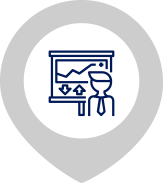Business model of the FED company
There is postulate in the economy — any joint-stock company works better than the state-owned company. Since 1990, State Corporation “FED” became a joint stock company. This ensured a number of advantages:
- the company has free access to foreign markets;
- the joint-stock company is more flexible in making decisions, and it is particularly appreciated by Western partners;
- the joint-stock company has easier access to cheap long-term loans (the example of the FED company proves the trust of the Western banks);
- capital assets are used more intensively, and, as a result of it, even with less headcount as compared to the staff quantity employed by similar state enterprise, output of products manufactured by the company is by 2–2.5 times higher.
The business model of the FED company shows how the company can work effectively under today's difficult economic conditions.




The FED company’s gross output per employee is almost comparable with European indicators. The company has achieved the level of the average gross production in Europe and North America. This indicator in the company is 50 thousand Euros per employee. For comparison, the average value for Ukrainian companies is a little more than 2000 Euros.
The cost of primary equipment owned by the FED company is 500 to 600 thousand Euros. This considerable investment in combination with measurement tools, instrumentation double the cost of equipment.
The company operates on the “24/7” basis, and under this mode of operation, at least 4 operators are required to operate each machine. There is a long-term system for training of highly qualified personnel. Therefore, the technical modernization has been in progress for about 7 years. Every year the company purchases 10 pieces of equipment. The total investment for 5–7 years was about 50 million Euros.
24/7
4 operators
About 1,000 persons employed by the company in recent years. Ration “white-collars” and “blue collars” – 1: 1. This ration includes not only machine operators, but cleaning staff and top management. This is a very competitive scheme. For example, at the state-owned enterprises, this ratio is 1 : 4. That means that “there are three to four employees per one employee who operates the machine”. It is beyond a shadow of a doubt that such scheme is inefficient and uncompetitive.
 1,000 employees
1,000 employees The company is growing at a quick rate by almost doubling its output. Every 3 to 4 years, we create up to 100 high-tech jobs. The cost of creating one job is 50 thousand Euros, excluding the cost of purchased primary equipment.
Withing 4 last years, the FED company invests 35 % of turnover in development: 10 % – in new equipment and technology and 25 % in new developments. This decision yields dividends: increased labour productivity that means the increased output of marketable products, and all this influences the future development, allows the company to plan activities for years to come. The growth rate that is at present is determined by technical re-equipment and smart marketing policy, work with customers allows the company to face the future with confidence.